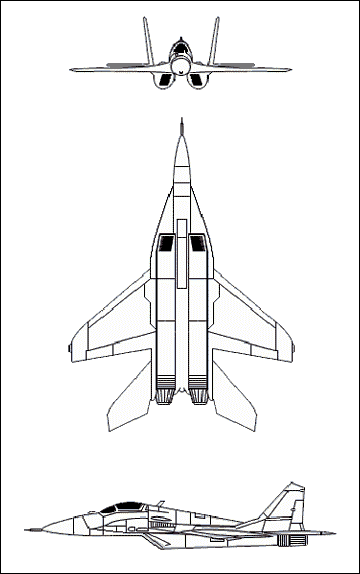|
Su-47
"Berkut" Technical Data

DESCRIPTION:
 Originally known as the S-37, Sukhoi redesignated its
advanced test aircraft as the Su-47 in 2002 reflecting the
decision to market the design as a production fighter rather
than as an experimental prototype. Also commonly referred to
as the Berkut (Golden Eagle), the Su-47 was originally built
as Russia's principle testbed for composite materials and
sophisticated fly-by-wire control systems.
Originally known as the S-37, Sukhoi redesignated its
advanced test aircraft as the Su-47 in 2002 reflecting the
decision to market the design as a production fighter rather
than as an experimental prototype. Also commonly referred to
as the Berkut (Golden Eagle), the Su-47 was originally built
as Russia's principle testbed for composite materials and
sophisticated fly-by-wire control systems.
The aircraft makes use of
forward-swept wings allowing superb maneuverability and
operation at angles of attack up to 45° or more. The
advantages of forward sweep have long been known as such
wings offer lower wave drag, reduced bending moments, and
delayed stall when compared to more traditional wing shapes.
Unfortunately, forward sweep also induces significant wing
twist that would shear most wings off the aircraft. To solve
this problem, the Su-47 makes use of composite materials
carefully tailored to resist twisting while still allowing
the wing to bend for improved aerodynamic behavior. To
reduce development costs, the S-37 borrowed the forward
fuselage, vertical tails, and landing gear of the Su-27
family.
Nonetheless, the aircraft includes reduced radar signature
features (including radar absorbent materials), an internal
weapons bay, and space set aside for an advanced radar.
Though similar in overall
concept to the American X-29 research aircraft of the 1980s,
the Su-47 is about twice the size and far closer to an
actual combat aircraft than the US design.
Su-47 has shown far superior manuvering in the air to any
aircraft known to this date.
Like the X-29 though, the Su-47 was primarily a technology
demonstrator, one intended to lay the foundation for the
next Russian fighter. Such a fighter must not only be as
advanced as the US F-22 and Eurofighter Typhoon, but must
also compete for funding with the more conventional MiGs.
However, Sukhoi is now attempting to market the Su-47 to the
Russian military and foreign customers as a production
fighter in its own right. Initial reaction was not good, but
the aircraft's performance has been so impressive that the
Russian government has made funds available for further
testing of the design.
Still, the low budgets of the Russian military and the
aircraft's high price tag make it unlikely that the Su-47
will be purchased any time in the near future.
Data below subject to change as
more details of the S-37 become available
|
|
HISTORY: |
|
First Flight |
25
September 1997 |
Service Entry
|
not
yet in service
|
|
CREW: |
1
pilot
|
|
ESTIMATED COST: |
unknown
|
|
AIRFOIL SECTIONS: |
|
Wing
Root |
unknown |
Wing
Tip
|
unknown
|
|
DIMENSIONS: |
|
Length |
72.83 ft (22.60 m) |
|
Wingspan |
74.00 ft (16.70 m) |
|
Height |
19.33 ft (5.90 m) |
|
Wing
Area |
666
ft2 (62.0 m2) |
Canard Area
|
unknown
|
|
WEIGHTS: |
|
Empty |
unknown |
|
Typical Load |
57,320 lb (26,000 kg) |
|
Max
Takeoff |
74,955 lb (34,000 kg) |
|
Fuel
Capacity |
internal: unknown
external: unknown |
Max
Payload
|
unknown
|
|
PROPULSION: |
|
Powerplant |
two
Aviadvigatel D-30F6 afterburning turbofans (original)
two Saturn/ Lyul'ka AL-37FU afterburning turbofans (planned)
|
|
Thrust |
68,340 lb (303.8 kN) [D-30F6]
37,480 lb (166.7 kN) [AL-37U]
63,930 lb (284.4 kN) [AL-37U] with afterburner
|
|
PERFORMANCE: |
|
Max
Level Speed |
at altitude: 1,555 mph (2,500 km/h)
at sea level: 870 mph (1,400 km/h) |
|
Initial Climb Rate |
45,275 ft (13,810 m) / min |
|
Service Ceiling |
61,680 ft (18,800 m) |
|
Range |
typical: 2,100 nm (3,880 km)
ferry: unknown
|
|
g-Limits |
unknown
|
|
ARMAMENT: |
|
Gun
|
one
30-mm GSh-30 cannon (150 rds) |
|
Stations |
one
internal weapons bay |
|
Air-to-Air Missile |
R-27/AA-10 Alamo, R-73/AA-11 Archer (presumably)
|
|
Air-to-Surface Missile |
unknown |
|
Bomb
|
unknown |
|
Other |
unknown
|
|
KNOWN VARIANTS: |
|
S-32
|
Original designation seen on the first prototype
|
|
S-37
|
New
designation for an experimental single-seat fighter
prototype; 1 built |
|
Su-47
|
Redesignation for the design as marketed by Sukhoi which has
promoted the aircraft as a production fighter
|
|
KNOWN COMBAT RECORD: |
not yet
in service
|
|
KNOWN OPERATORS: |
none
|
|
|
|
|